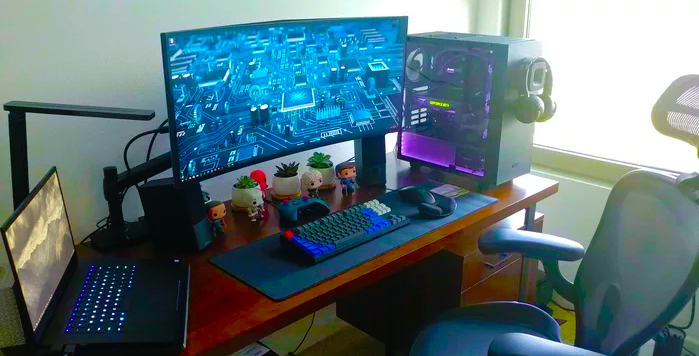It can be hard to know where to start when choosing a new gaming laptop. There is a range of features to consider, including the display, form factor, battery life and of course, the components powering it all.
Upgrading a gaming laptop with new hardware is not usually feasible, so it is essential to plan ahead and think about how you want to use your system. Prioritizing the features that are most important to you is a great first step.

Display
The right display can significantly impact on your gaming experience but there are more factors to consider than just the screen size. Here are a few factors to consider:
-
Resolution
The higher the resolution, the more pixels appear on the screen, which will mean a clearer image. Newer laptops may feature 1440p or 4k screens in place of the 1080p standard but the hardware required to power games at these resolutions is likely to add to the cost.
-
Refresh Rate
A higher refresh rate display can help the action on-screen appear smoother and easier to follow. It achieves this by redrawing the image more times per second. Many gaming laptop displays make use of this technology.
-
Organic Light-Emitting Diode (OLED)
Available on some gaming laptops, these screens use pixels that produce their own light rather than relying on a backlight. This means that they can achieve deeper black levels and more contrast than most laptop screens which are often LED-lit liquid crystal displays.
Central Processing Unit (CPU)
The CPU acts as the “brain” of your laptop. It sends signals to the other components in your system and processes the instructions sent by all the software running on your machine.
Your choice of CPU can have a significant impact on everything you do, from the frame rates you see in games to the response times of applications and even the laptop’s battery life.
To maintain consistent in-game performance while streaming or recording gameplay, we recommend at least a Core i7 processor. Higher clock speeds and core counts are critical if you are interested in live streaming gameplay, as capture software often requires significant processing power to encode video.
Graphics Processing Unit (GPU)

A laptop’s GPU creates the pixels that form the images on your screen while gaming. Along with your CPU, it is the key to enjoying smooth frame rates and high-resolution gameplay. Here are a few factors to consider:
-
Frame Rate and Resolution
Ensure your gaming laptop’s GPU and CPU can hit consistent frame rates while rendering the proper resolution of your screen or external display. Compare the CPU and GPU in the laptop you are considering to the system requirements of the games you are hoping to play to get a sense of how they will perform.
-
Display Refresh Rate
If you have invested in a 144Hz screen, you will want a GPU that consistently achieves 144 FPS (or higher) to get the full benefit of the higher refresh rate.
-
Ray Tracing
If you plan to enable hardware-intensive rendering techniques like ray tracing technology, check the relevant benchmarks to judge how it will impact performance beforehand.
Storage
Solid-state drives (SSDs) outperform older mechanical drives (HDDs) in most areas that impact gaming. SSDs use a type of flash memory (NAND) to electronically read and write blocks of data without any moving parts.
One key advantage of SSDs over HDDs is high random read/write speeds which means they can quickly access data stored in different places on the drive. They generally load programs and files faster than a comparably sized HDD and help cut down on system startup times.
Random Access Memory (RAM)
Ram is the memory that temporarily stores data for rapid retrieval by your CPU. Unlike an SSD or HDD, it does not permanently store data and resets whenever it loses power but it also makes that frequently used data available faster than a storage drive.
How much RAM you need in your laptop depends on how you plan to use the system:
-
2-4GB
2-4GB of Ram can be enough for browsing the internet, lightweight work applications or older games.
-
8GB
8GB of RAM can be enough for mid-range gaming and most work applications. Many modern PC games list 8GB of RAM or more as a minimum system requirement.
-
16GB
16GB of RAM allows a system to run newer and more resource-intensive games at higher settings, multiple apps (like voice chat or video highlight recording) and streaming software.
-
32GB
32GB of RAM is ideal for resource-intensive multitasking, including gaming, content creating and anyone who frequently utilizes memory-intensive processes like video editing and rendering.
Laptop Cooling
Improvements in cooling have allowed laptop manufacturers to upend the old stereotype of thick, unwieldy gaming laptops. Today, some of the most powerful systems on the market are thin laptops with meticulously engineered cooling systems.
Though their internal workings are complex, the fundamentals of cooling systems in laptops still mostly consist of vents, fans, cooling pipes and heatsinks. That said, tremendous progress has been made in how these cooling tools are designed and implemented, allowing for the smaller form factors we see in modern gaming laptops.
Comparing one system’s cooling to another can be difficult from the manufacturer’s description alone, so it’s worth checking reviews to learn about real-world performance and how it might relate to your usage needs.
Let us know in the comment section below how you select your gaming laptop.

